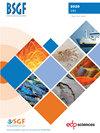新生代tsamfidet白垩纪海槽构造-岩浆活动(Aïr,尼日尔)
IF 2.6
3区 地球科学
Q2 GEOSCIENCES, MULTIDISCIPLINARY
引用次数: 7
摘要
Tefidet海槽(尼日尔东部)属于白垩纪断裂Tenere大系统组,方向为N130°E ~ N170°E,与乍得湖-霍格格湖构造轴方向相对应。通过对Tefidet海槽构造与渐新世至上新世-第四纪碱性裂陷火山作用关系的研究,表明Tefidet海槽与邻近的当代Hoggar、喀麦隆和南气区相比具有独特性。白垩纪Tefidet海槽的构造-岩浆活动分两个阶段进行:与图阿雷格地盾膨胀(Air, Hoggar, Iforas)同期;-随后的延伸期,一般为N060°E,自南大西洋打开以来一直持续(上侏罗统至上纪-第四纪)。从渐新世到上第四纪,伴随着N060°E伸展(玄武岩充填的同岩浆微裂缝),泛非断裂和白垩纪断裂的再活化形成了裂隙火山作用。这项研究强调了火山活动平静期和恢复期的存在,对此可以做出两种假设:没有足够的绝对年代测定,裂谷的多阶段延伸。后一种假设似乎得到了火山平静的三个时期的支持,分别是在北部和南部的空气中观测到的28-24个月,20-14个月和8-5个月,分别是在格雷本和托加。本文章由计算机程序翻译,如有差异,请以英文原文为准。
Tectono-magmatic reactivation of Téfidet Cretaceous trough during Cenozoic (Aïr, Niger)
The Tefidet trough (eastern Niger) belongs to the Tenere megasystem set of Cretaceous rifts N130°E to N170°E oriented, corresponding to the direction of the Lake Chad-Hoggar tectonic axis. The study of the relationship between the structure of the trough and alkaline fissural volcanism that developed there from the Oligocene to Plio-Quaternary shows the uniqueness of the Tefidet trough compared to the neighboring contemporary volcanic areas of Hoggar, Cameroon, and southern Air. The tectono-magmatic reactivation of the Cretaceous Tefidet trough developed in two steps:
– a period contemporaneous with the Tuareg shield bulging (Air, Hoggar, Iforas); – a subsequent extension period generally N060°E, which has persisted since the opening of the South Atlantic (upper Jurassic to Plio-Quaternary). The fissural volcanism, due to the reactivation of Pan African and Cretaceous faults evolved concomitantly with the N060°E extension (syn-magmatic micro-fractures with basaltic filling), in several steps, from Oligocene to Plio-Quaternary. This study highlights the existence of periods of quietness and recovery of volcanic activity, for which two assumptions can be made:
– no enough absolute datings, – apolyphased extension of the rift. The latter hypothesis seems to be supported by three periods of volcanic quietness, 28–24 m.y., 20–14 m.y. and 8–5 m.y., observed in the northern and the southern Air, Greboun and Todgha, respectively.
求助全文
通过发布文献求助,成功后即可免费获取论文全文。
去求助
来源期刊
CiteScore
5.80
自引率
0.00%
发文量
18
审稿时长
>12 weeks
期刊介绍:
BSGF - Earth Sciences Bulletin publie plusieurs types de contributions :
1. des articles originaux, couvrant tous les champs disciplinaires des Géosciences, à vocation fondamentale mais également à vocation plus appliquée (risques, ressources);
2. des articles de synthèse, faisant le point sur les avancées dans un domaine spécifique des Géosciences, qu''elles soient méthodologiques ou régionales ;
3. des monographies sur la géologie d’une région donnée, assorties d’informations supplémentaires, cartes, coupes, logs, profils sismiques … publiées en ligne en annexe de l’article ;
4. des articles courts de type « express letter » ;
5. des livrets-guides d’excursion (qui suivront le même processus d’examen éditorial que les articles plus classiques) ;
6. des comptes rendus de campagnes à la mer ;
7. des articles de données géodésiques, géophysiques ou géochimiques, pouvant devenir des articles de référence pouvant conduire à des interprétations ultérieures.
BSGF - Earth Sciences Bulletin constitue également un forum pour les discussions entre spécialistes des Sciences de la Terre, de type comment-reply ou autre. Tous les articles publiés, quelle que soit leur forme, seront accessibles sans frais (articles en Open Access) sur le site de la SGF et sur celui de Geosciences World dans la mesure où les auteurs se seront acquittés d’une contribution de (Article Processing Charges – APC) de 300€ pour les membres de la SGF et 500€ pour les non-membres.

 求助内容:
求助内容: 应助结果提醒方式:
应助结果提醒方式:


